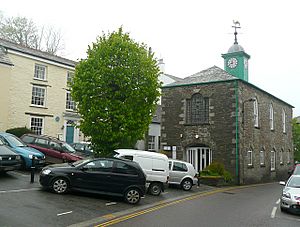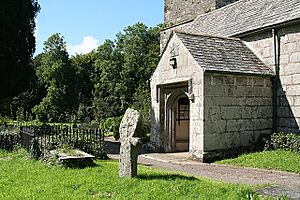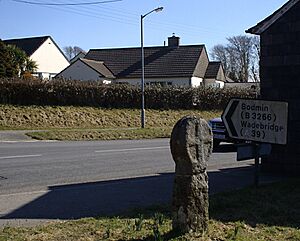Camelford facts for kids
Quick facts for kids Camelford
|
|
|---|---|
 Camelford Town Hall |
|
| Lua error in Module:Location_map at line 530: Unable to find the specified location map definition: "Module:Location map/data/Cornwall (mainland)" does not exist. | |
| Population | 2,945 (Town Census, 2011) |
| OS grid reference | SX101831 |
| Civil parish |
|
| Unitary authority | |
| Ceremonial county | |
| Region | |
| Country | England |
| Sovereign state | United Kingdom |
| Post town | CAMELFORD |
| Postcode district | PL32 |
| Dialling code | 01840 |
| Police | Devon and Cornwall |
| Fire | Cornwall |
| Ambulance | South Western |
| EU Parliament | South West England |
| UK Parliament |
|
Camelford (Cornish: Reskammel) is a small town in northern Cornwall, England. It is located in the River Camel valley, close to Bodmin Moor. The town is about 16 kilometers (10 miles) north of Bodmin. Camelford is governed by its own Town Council. In 2011, the town had a population of 865 people. The wider area, called a ward, had about 4,001 residents. The church parish for Camelford is called Lanteglos-by-Camelford.
Camelford is part of the North Cornwall parliamentary area. This area is represented by a Member of Parliament (MP). Since 2015, Scott Mann has been the MP for this area. For many years, Camelford was the main office for the Camelford Rural District. Today, it is represented on Cornwall Council by the Camelford and Boscastle ward.
The main industries around Camelford are a slate quarry in Delabole and a cheese factory in Davidstow. There is also a small industrial area called Highfield. The A39 road, also known as the 'Atlantic Highway', goes right through the town. People have talked about building a bypass road for many years. Camelford Station used to be open but closed in 1966. Its site was later used as a cycling museum.
Contents
What's in a Name?
The Cornish name for Camelford is Reskammel. This name comes from two Middle Cornish words. "Rys" means "ford," which is a shallow place in a river where you can cross. "Kammel" is the Cornish name for the River Camel, meaning "crooked" or "skew-whiff." So, Reskammel means "ford over the crooked river." This name was created in the 20th century.
The English name Camelford was made by changing the river's name to Camel and adding Ford. This gives it the same meaning as its Cornish name. The earliest records of the name are from 1205 and 1256.
Because the river's name sounds like the animal "camel," the camel has become a symbol of the town. You can see a camel on the town's coat of arms. It is also on the logo of Sir James Smith's School and other local symbols.
Camelford's Location and Surroundings
Camelford is located near the highest points in Cornwall. This means it often gets a lot of rain. For example, on June 8, 1957, 203 millimeters (about 8 inches) of rain fell in Camelford! Roughtor is a hill on Bodmin Moor close to the town. You can find many ancient remains from prehistoric times nearby.
Camelford Town Hall was built in 1806. Today, it is used as a public library. Near the river, you can find Enfield Park. Small villages and areas in the parish include Helstone, Tregoodwell, Valley Truckle, Hendra, Lanteglos, Slaughterbridge, Tramagenna, Treforda, and Trevia. The local economy mostly relies on farming and tourism. There was also a china clay factory at Stannon.
Interesting Places to Visit
Camelford used to have the North Cornwall Museum and Gallery. This museum showed paintings and items important to local history. It has since been turned into houses. To the northwest, at Slaughterbridge, there is an Arthurian Centre. This center explores the legends of King Arthur. Near Camelford Station, there was a Cycling Museum, but it is now closed. To the east, you can see the hills of Roughtor and Brown Willy. To the south are the old churches of Lanteglos and Advent.
Getting Around Camelford
The main road through Camelford is the A39, also known as the Atlantic Highway. There is a bus service that runs three times a day from Newquay to Exeter, stopping in Launceston and Camelford. A planned bypass road for the town is currently on hold. This means traffic can still be a problem, especially during busy summer weekends.
From 1893 to 1966, Camelford had a train station on the North Cornwall Railway. A bus used to shuttle people between the town and the station. Since the train line closed, the closest train station is Bodmin Parkway, which is about 22.5 kilometers (14 miles) away.
Camelford's Past
Early Times
Some old stories link Camelford to the famous legendary city of Camelot. It has also been connected to the battle of Camlann, where King Arthur was said to have fought his last battle. Writers like Layamon in the 13th century and John Aubrey in the 17th century mentioned this link. Aubrey even wrote that pieces of armor were often found when digging in Camelford. However, modern historians do not believe these links are true.
Camelford has also been linked to a battle against the West Saxons at a place called Gafulford. This idea goes back to the 16th century. But today, historians think that battle probably happened at Galford in Devon. The nearby place Slaughterbridge was also thought to be a battle site. This was a mistake because "slaughter" in its name actually came from an old Anglo-Saxon word for "marsh," not a battle.
Helstone Manor
Helstone (also called Helston in Trigg) was a very important manor in the Middle Ages. It was a main part of the Hundred of Trigg area. It might have even been where a local leader lived in Celtic times. In the Domesday Book, a survey from 1086, this manor was owned by Earl Robert of Mortain. It was a large area with land for many farms and animals. It was one of the 17 old manors that belonged to the Duchy of Cornwall.
More Recent History
Camelford became a special area that could elect members to Parliament in 1259. Later, the town elected two members to the Unreformed House of Commons. The first MPs from Camelford were in Parliament in 1552. However, by the early 1800s, these seats were often bought with bribes. Camelford was known as a "rotten borough," meaning it had very few voters but still elected MPs. In 1832, the Camelford parliamentary area was removed by the Great Reform Act. The town then became part of the East Cornwall area.
In February 1837, people in Camelford protested against the New Poor Law. This law created workhouses for poor people. Protesters tried to stop a Poor Law Commissioner from entering the town. They wanted to prevent the law from being put in place. About 400 to 500 people joined the protests, some playing drums and fifes. Many were workers from nearby quarries. In response, 60 soldiers and six police officers were sent to Camelford. Although a newspaper said the protesters had "riotous intentions," no violence was reported. One man, James Silbey, was arrested. He had spoken out against the New Poor Law. He was sent to Bodmin Jail but later got bail. Despite the protests, a workhouse was eventually built in Camelford.
The town's official seal shows a camel crossing a ford in water. The words on the seal mean "Seal of the Town of Camelford."
In 2012, Camelford hosted Gorsedh Kernow. This is a special event that celebrates Cornish culture and language.
Water Pollution Incident
In July 1988, the town's water supply became polluted. This happened when 20 tons of a chemical called aluminium sulphate was accidentally put into the wrong tank. This happened at the Lowermoor Water Treatment Works on Bodmin Moor. This was a very serious incident. An investigation into what happened started in 2002. A report was released in 2005.
Churches and Schools
The main church for Camelford is the parish church of Camelford. It is located in Lanteglos by Camelford. This church is dedicated to St Julitta. There is also a Church of St Thomas of Canterbury in the town itself, which opened in 1938. Near Camelford, at Jetwells, there is a holy well. "Jetwells" comes from "Julitta's well." In old times, there was also a chapel dedicated to St Thomas, but it likely stopped being used after the Reformation. The priest for Lanteglos also looks after the nearby parish of Advent.
In Market Place, you can find the Methodist Church. It was originally a Wesleyan Methodist Chapel. John Wesley, who started Methodism, visited Camelford many times. There is also an older Methodist chapel on Chapel Street that is no longer used.
Soul's Harbour Pentecostal Church is located near the car park. It is part of The Assemblies of God of Great Britain. This church was started in 1987. The building it uses was built as a Church School in 1846.
Sir James Smith's School provides secondary education for students in Camelford and the surrounding area. There is also a primary school for younger children.
Cornish Wrestling
Cornish wrestling competitions were held in Camelford in the 1800s. Wrestlers would compete for prizes.
Media in Camelford
Local TV news for Camelford comes from BBC South West and ITV West Country. Radio stations that broadcast to the town include BBC Radio Cornwall, Heart West, NCB Radio, and Pirate FM. The local newspaper that serves Camelford is the Cornish & Devon Post. It is published every Thursday.
Famous People from Camelford
Many notable people have connections to Camelford.
- The naval officer Samuel Wallis was born near Camelford. He was famous for sailing around the world.
- Francis Hurdon, a Canadian politician, was also born in Camelford.
- Two members of the Pitt family held the title of Baron Camelford: Thomas Pitt, 1st Baron Camelford (1737–1793) and Thomas Pitt, 2nd Baron Camelford (1775–1804).
- Samuel Pollard, a missionary who worked in China, was born in Camelford.
- Jason Dawe, who used to present the TV show Top Gear, is from the town.
See also
 In Spanish: Camelford para niños
In Spanish: Camelford para niños








